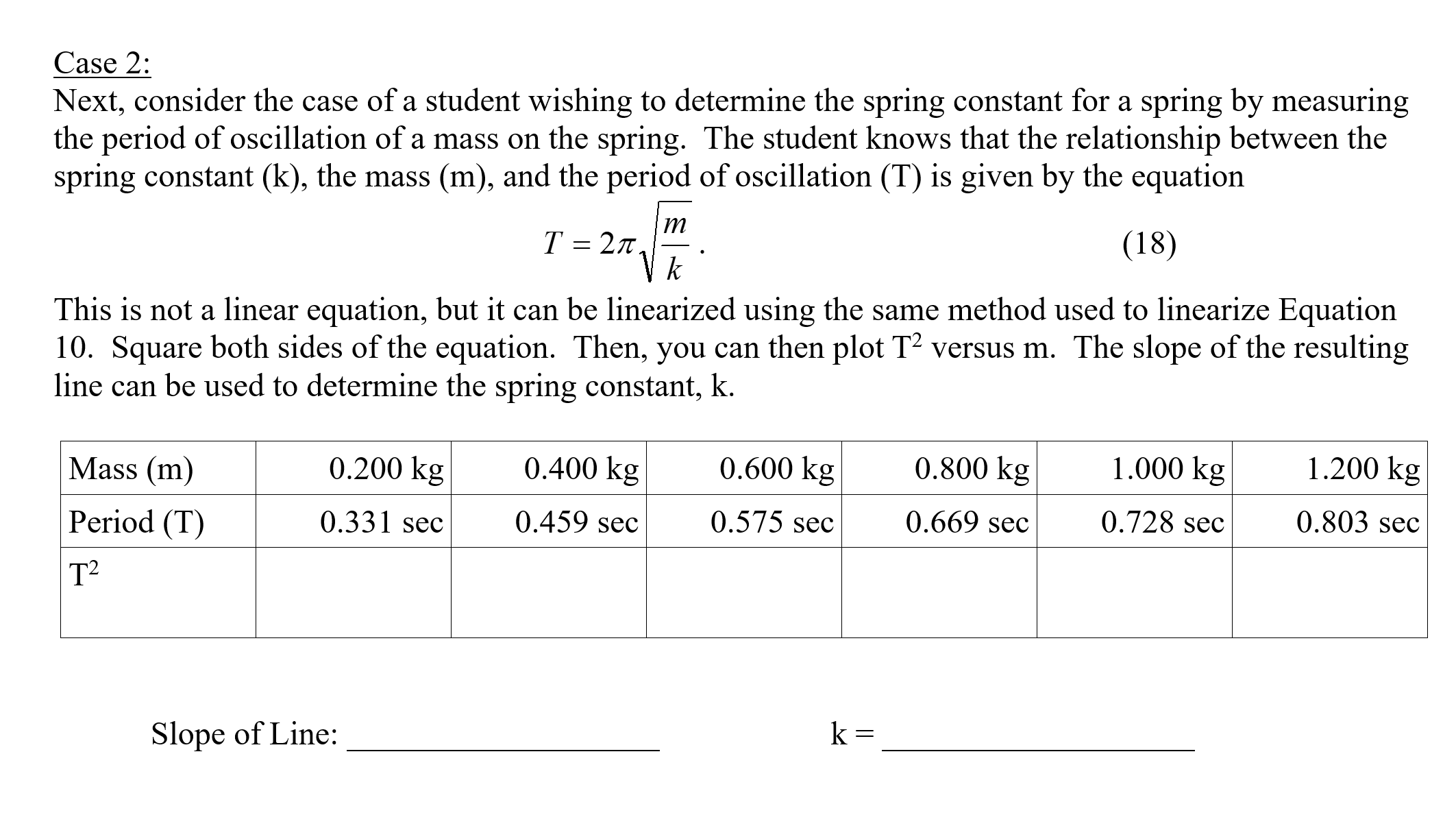Case 2: Next, consider the case of a student wishing to determine the spring constant for a spring by measuring the period of oscillation of a mass on the spring. The student knows that the relationship between the spring constant (k), the mass (m), and the period of oscillation (T) is given by the equation m T = 2n. (18) V k This is not a linear equation, but it can be linearized using the same method used to linearize Equation 10. Square both sides of the equation. Then, you can then plot T² versus m. The slope of the resulting line can be used to determine the spring constant, k. Mass (m) 0.200 kg 0.400 kg 0.600 kg 0.800 kg 1.000 kg 1.200 kg Period (T) 0.331 sec 0.459 sec 0.575 sec 0.669 sec 0.728 sec 0.803 sec T2
Case 2: Next, consider the case of a student wishing to determine the spring constant for a spring by measuring the period of oscillation of a mass on the spring. The student knows that the relationship between the spring constant (k), the mass (m), and the period of oscillation (T) is given by the equation m T = 2n. (18) V k This is not a linear equation, but it can be linearized using the same method used to linearize Equation 10. Square both sides of the equation. Then, you can then plot T² versus m. The slope of the resulting line can be used to determine the spring constant, k. Mass (m) 0.200 kg 0.400 kg 0.600 kg 0.800 kg 1.000 kg 1.200 kg Period (T) 0.331 sec 0.459 sec 0.575 sec 0.669 sec 0.728 sec 0.803 sec T2
University Physics Volume 1
18th Edition
ISBN:9781938168277
Author:William Moebs, Samuel J. Ling, Jeff Sanny
Publisher:William Moebs, Samuel J. Ling, Jeff Sanny
Chapter15: Oscillations
Section: Chapter Questions
Problem 29P: A mass m0is attached to a spring and hung vertically. The mass is raised a short distance in the...
Related questions
Question
100%
I am having a hard time finding the meaning of what T2 is in the equation. Do I just square the T or do something else? Thanks for the help in advanced.

Transcribed Image Text:Case 2:
Next, consider the case of a student wishing to determine the spring constant for a spring by measuring
the period of oscillation of a mass on the spring. The student knows that the relationship between the
spring constant (k), the mass (m), and the period of oscillation (T) is given by the equation
m
T = 2n.
(18)
V k
This is not a linear equation, but it can be linearized using the same method used to linearize Equation
10. Square both sides of the equation. Then, you can then plot T² versus m. The slope of the resulting
line can be used to determine the spring constant, k.
Mass (m)
0.200 kg
0.400 kg
0.600 kg
0.800 kg
1.000 kg
1.200 kg
Period (T)
0.331 sec
0.459 sec
0.575 sec
0.669 sec
0.728 sec
0.803 sec
T2
Expert Solution
This question has been solved!
Explore an expertly crafted, step-by-step solution for a thorough understanding of key concepts.
This is a popular solution!
Trending now
This is a popular solution!
Step by step
Solved in 6 steps with 6 images

Knowledge Booster
Learn more about
Need a deep-dive on the concept behind this application? Look no further. Learn more about this topic, physics and related others by exploring similar questions and additional content below.Recommended textbooks for you

University Physics Volume 1
Physics
ISBN:
9781938168277
Author:
William Moebs, Samuel J. Ling, Jeff Sanny
Publisher:
OpenStax - Rice University

Classical Dynamics of Particles and Systems
Physics
ISBN:
9780534408961
Author:
Stephen T. Thornton, Jerry B. Marion
Publisher:
Cengage Learning

Physics for Scientists and Engineers: Foundations…
Physics
ISBN:
9781133939146
Author:
Katz, Debora M.
Publisher:
Cengage Learning

University Physics Volume 1
Physics
ISBN:
9781938168277
Author:
William Moebs, Samuel J. Ling, Jeff Sanny
Publisher:
OpenStax - Rice University

Classical Dynamics of Particles and Systems
Physics
ISBN:
9780534408961
Author:
Stephen T. Thornton, Jerry B. Marion
Publisher:
Cengage Learning

Physics for Scientists and Engineers: Foundations…
Physics
ISBN:
9781133939146
Author:
Katz, Debora M.
Publisher:
Cengage Learning